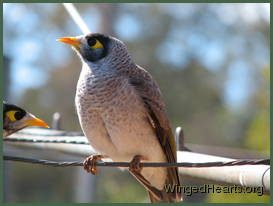How To Recognise Individual Birds - Part 2
Today we continue to look at the key features that enable us to recognise individual birds.
Once our eyes get used to the differences in the shapes and sizes of the birds in a species. We can start training ourselves to look for more distinguishing characteristics.
- Look at the top of their heads? Does the bird have a smooth or fuzzy head? Is it more round or slightly flat?
- Does the bird have a crest, if so how big is it?
- Then look at their shape of the wings. Do they sag or are they folded tightly?

- Does the right wing cross over the left, or the other way round or do they meet nicely in the centre?
- Look at the patterns of colour around their faces, necks, chests, backs, legs and wings. In the examples below you will see the shapes are different for each bird, even though at first glance the birds appear to be similar.
- How long is their beak? What is the shape of their mouths?
- Do they have any distinguishing parks on their beaks and cheeks?
In the picture on the right (above), the shape of the mask around the eyes, under the chin as well as the marks where the beaks
meet the cheek are all individual characteristics. Renutu (noisy-miner) does not have a goatie in the centre of his mask unlike his sister Chipkin in the picture below.
 In the picture on the left, looking from the side Chipkin does not have the light stripe along the edge of her wing around the midway unlike Renutu in the picture above.
In the picture on the left, looking from the side Chipkin does not have the light stripe along the edge of her wing around the midway unlike Renutu in the picture above.
Also look at the pattern under the tail of Sophie magpie and the shape of her neck and beak. These too are distinctive features.
Soon you will find that the birds are all as unique in their faces and bodies as us humans. Having said that, do not be too harsh on yourself for not being able to spot all the differences. The brains of each species is designed to recognise members of their own kind best. To notice the differences in small and flitty birds or birds with colours with little contrast to our eyes is difficult and takes a lot of practice.
Tomorrow I will tell you of some more ways that help make recognising individual birds easier.
In the meantime if you would like read Part 1 of How To Recognise Individual Birds click here.
For a copy of the 23 Amazing Facts About Wild Bird Culture with true stories - click on this link and enter your details.
To read the earlier articles in this blog challenge click here.
Until tomorrow,
Cheers
Gitie


 del.icio.us
del.icio.us Digg
Digg Facebook
Facebook Google
Google Google+
Google+ LinkedIn
LinkedIn MySpace
MySpace Ping This!
Ping This! SlashDot
SlashDot StumbleUpon
StumbleUpon Twitter
Twitter Yahoo
Yahoo





